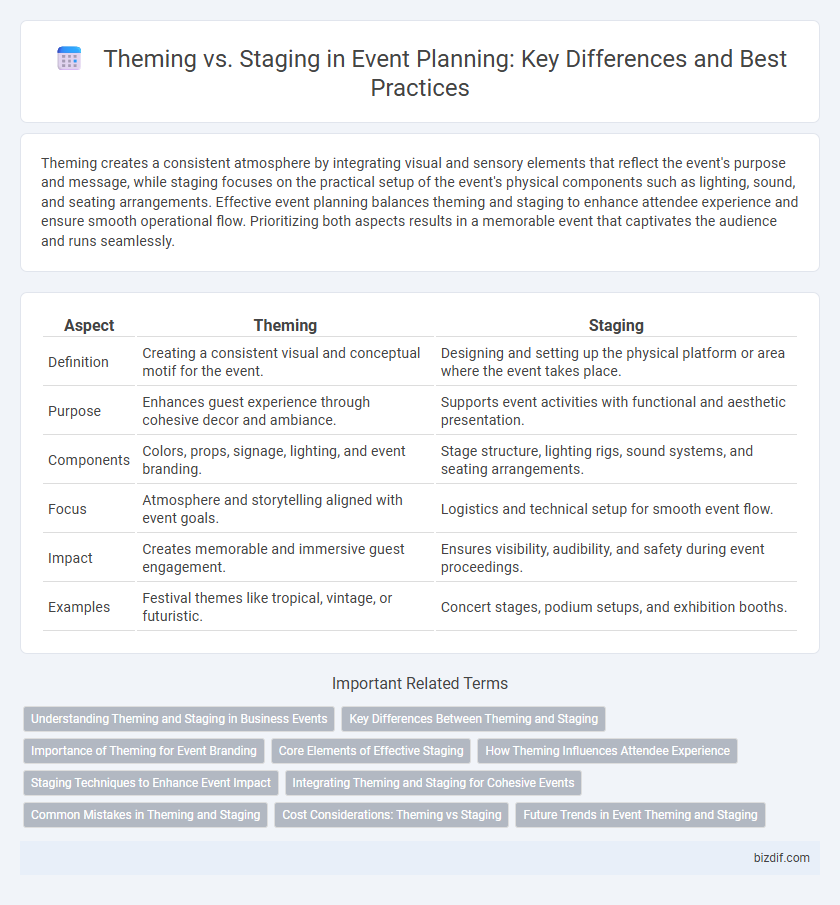Theming creates a consistent atmosphere by integrating visual and sensory elements that reflect the event's purpose and message, while staging focuses on the practical setup of the event's physical components such as lighting, sound, and seating arrangements. Effective event planning balances theming and staging to enhance attendee experience and ensure smooth operational flow. Prioritizing both aspects results in a memorable event that captivates the audience and runs seamlessly.
Table of Comparison
| Aspect | Theming | Staging |
|---|---|---|
| Definition | Creating a consistent visual and conceptual motif for the event. | Designing and setting up the physical platform or area where the event takes place. |
| Purpose | Enhances guest experience through cohesive decor and ambiance. | Supports event activities with functional and aesthetic presentation. |
| Components | Colors, props, signage, lighting, and event branding. | Stage structure, lighting rigs, sound systems, and seating arrangements. |
| Focus | Atmosphere and storytelling aligned with event goals. | Logistics and technical setup for smooth event flow. |
| Impact | Creates memorable and immersive guest engagement. | Ensures visibility, audibility, and safety during event proceedings. |
| Examples | Festival themes like tropical, vintage, or futuristic. | Concert stages, podium setups, and exhibition booths. |
Understanding Theming and Staging in Business Events
Theming in business events involves creating a cohesive narrative or concept that aligns with the brand's message and engages attendees on an emotional level through decor, color schemes, and interactive elements. Staging focuses on the technical setup, including lighting, sound, and spatial arrangement, to enhance visibility and ensure smooth execution of presentations and performances. Combining effective theming with strategic staging enhances attendee experience while reinforcing the event's purpose and messaging.
Key Differences Between Theming and Staging
Theming involves creating a cohesive visual and experiential concept that reflects a specific idea or story, often incorporating colors, decorations, and props to immerse attendees in a particular atmosphere. Staging focuses on the structural and technical setup, including lighting, sound, and platform design, to support performances or presentations. The key difference lies in theming enhancing the event's narrative and emotional appeal, while staging ensures functional and aesthetic support for event logistics and visibility.
Importance of Theming for Event Branding
Theming plays a crucial role in event branding by creating a cohesive and immersive experience that reinforces the brand's identity and message. Unlike staging, which primarily focuses on the physical setup and technical aspects, theming integrates visual elements, color schemes, and design motifs that resonate emotionally with attendees and enhance brand recall. Strong theming transforms an event from a mere gathering into a memorable brand experience, driving engagement and loyalty.
Core Elements of Effective Staging
Effective staging in event planning centers on three core elements: cohesive design, strategic lighting, and functional layout. Cohesive design ensures all visual components align with the event's theme, enhancing attendee immersion without overwhelming them. Strategic lighting highlights key moments and spaces to create ambiance and guide focus, while a functional layout optimizes flow and accessibility, maximizing guest experience and engagement.
How Theming Influences Attendee Experience
Theming in event planning creates a cohesive and immersive environment that enhances attendee engagement and emotional connection by aligning visual elements, activities, and messaging with a central concept. Unlike staging, which emphasizes the physical setup of the event space, theming integrates storytelling and sensory details to deepen participant involvement and memory retention. Effective theming boosts brand recall and satisfaction, making the event experience more memorable and impactful for attendees.
Staging Techniques to Enhance Event Impact
Staging techniques significantly boost event impact by creating immersive environments through dynamic lighting, sound design, and flexible set pieces tailored to the event's theme. Effective use of multimedia projections and elevated platforms enhances audience engagement and visual focus, transforming the space into a captivating experience. Integrating advanced technology like LED screens and interactive elements further elevates the atmosphere, ensuring the event leaves a lasting impression.
Integrating Theming and Staging for Cohesive Events
Integrating theming and staging enhances event ambiance by aligning visual design, props, and spatial layout with the overall concept, creating a seamless guest experience. Effective collaboration between creative teams ensures thematic elements complement staging techniques, amplifying emotional impact and engagement. Cohesive events leverage synchronized lighting, decor, and interactive installations to reinforce the narrative and immerse attendees fully.
Common Mistakes in Theming and Staging
Common mistakes in theming include overcomplicating design elements that overshadow the event's purpose and neglecting consistency across all visual components, leading to a fragmented experience. In staging, frequent errors involve inadequate lighting and sound setup that compromise visibility and audio clarity, as well as poor spatial arrangement that disrupts audience engagement and movement. Addressing these issues requires thorough planning and coordination between creative and technical teams to ensure seamless execution.
Cost Considerations: Theming vs Staging
Theming often demands higher upfront investment due to the need for custom decor, props, and immersive design elements tailored to specific narratives or brand identities. Staging typically incurs lower costs by focusing on functional arrangements, such as lighting, seating, and equipment setup, which can be reused across multiple events. Budget allocation should weigh the thematic impact versus the practical efficiency of staging to optimize financial resources.
Future Trends in Event Theming and Staging
Future trends in event theming and staging emphasize immersive technologies such as augmented reality (AR) and virtual reality (VR) to create more engaging and interactive experiences. Sustainable materials and eco-friendly design practices are gaining importance as events strive for environmental responsibility while maintaining aesthetic impact. Integration of AI-driven personalization enables dynamic themes and adaptive staging that respond in real time to attendee preferences and event flow.
Theming vs Staging Infographic

 bizdif.com
bizdif.com